The Best Software for Financial Planning and Analysis (FP&A): A Comprehensive Guide

Financial Planning and Analysis (FP&A) is a critical function for businesses of all sizes, enabling them to forecast future performance, allocate resources effectively, and make data-driven decisions. With the increasing complexity of financial data and the need for real-time insights, FP&A software has become indispensable. In this article, we’ll explore the best FP&A software solutions available today, highlighting their features, strengths, and ideal use cases.
Key Features to Look for in FP&A Software
Before diving into specific tools, it’s essential to understand the key features that make FP&A software effective:
- Data Integration : The ability to connect with multiple data sources (e.g., ERP systems, CRM platforms, spreadsheets).
- Scenario Planning : Tools for creating “what-if” scenarios to test different business strategies.
- Real-Time Reporting : Dashboards and visualizations that provide up-to-date insights.
- Collaboration : Features that allow teams to work together seamlessly on budgets, forecasts, and reports.
- Automation : Streamlining repetitive tasks like data entry and report generation.
- Scalability : The capacity to grow with your business as data volume and complexity increase.
- Security : Robust measures to protect sensitive financial information.
Top FP&A Software Solutions
1. Anaplan
- Best For : Enterprise-level FP&A with advanced modeling capabilities.
- Key Features :
- Cloud-based platform for real-time collaboration.
- Hyperblock technology for complex calculations.
- Scenario planning and predictive analytics.
- Pre-built templates for budgeting, forecasting, and workforce planning.
- Why It’s Great : Anaplan excels in handling large datasets and complex models, making it ideal for enterprises with intricate planning needs. Its flexibility allows users to create custom workflows tailored to their specific requirements.
Ideal Use Case : Large corporations, multinational organizations, and industries requiring detailed scenario analysis (e.g., retail, manufacturing).
2. Adaptive Insights (Workday Adaptive Planning)
- Best For : Mid-market to enterprise companies seeking intuitive FP&A tools.
- Key Features :
- Seamless integration with Workday and other ERP systems.
- Drag-and-drop interface for easy model building.
- Automated reporting and dashboards.
- Collaborative budgeting and forecasting.
- Why It’s Great : Adaptive Insights offers a user-friendly experience without sacrificing power. Its strong integration with Workday makes it particularly appealing for organizations already using Workday HR or finance modules.
Ideal Use Case : Mid-sized businesses, SaaS companies, and organizations looking for robust yet accessible FP&A tools.
3. Oracle Hyperion Planning
- Best For : Enterprises with deep Oracle ecosystem investments.
- Key Features :
- Advanced financial consolidation and reporting.
- Integrated budgeting, forecasting, and profitability analysis.
- Support for multi-currency and multi-entity environments.
- AI-powered insights through Oracle Analytics.
- Why It’s Great : Oracle Hyperion Planning is designed for large-scale enterprises with complex financial structures. Its integration with Oracle databases ensures smooth data flow across departments.
Ideal Use Case : Global enterprises, financial institutions, and companies heavily reliant on Oracle products.
4. SAP Business Planning and Consolidation (BPC)
- Best For : SAP-centric organizations needing comprehensive FP&A capabilities.
- Key Features :
- Unified platform for budgeting, forecasting, and consolidation.
- Real-time data processing and analytics.
- Integration with SAP S/4HANA and other SAP modules.
- Mobile access for on-the-go decision-making.
- Why It’s Great : SAP BPC leverages the power of SAP’s ecosystem to deliver end-to-end FP&A solutions. It’s particularly suited for businesses already embedded in the SAP environment.
Ideal Use Case : Large enterprises, supply chain-focused companies, and organizations invested in SAP technologies.
5. Prophix
- Best For : Mid-market companies seeking affordability and ease of use.
- Key Features :
- Automated budgeting, forecasting, and reporting.
- Built-in financial consolidation and compliance tools.
- Drill-down capabilities for granular analysis.
- Strong customer support and training resources.
- Why It’s Great : Prophix strikes a balance between functionality and accessibility, making it a popular choice for mid-market businesses. Its automation features reduce manual effort and improve accuracy.
Ideal Use Case : Mid-sized businesses, non-profits, and organizations with limited IT resources.
6. Planful (formerly Host Analytics)
- Best For : Cloud-based FP&A with strong collaboration features.
- Key Features :
- Continuous planning capabilities for rolling forecasts.
- Collaborative budgeting and approval workflows.
- Customizable dashboards and KPI tracking.
- AI-driven insights for trend analysis.
- Why It’s Great : Planful emphasizes continuous planning, allowing businesses to adapt quickly to changing conditions. Its cloud-based architecture ensures accessibility and scalability.
Ideal Use Case : Growing businesses, subscription-based models, and teams focused on agile planning.
7. Vena Solutions
- Best For : Excel-centric organizations seeking modern FP&A tools.
- Key Features :
- Native Excel integration for familiar workflows.
- Automated data collection and validation.
- Scenario modeling and driver-based planning.
- Centralized repository for all financial data.
- Why It’s Great : Vena combines the familiarity of Excel with the power of modern FP&A software. This makes it an excellent choice for organizations hesitant to abandon spreadsheet-based processes.
Ideal Use Case : Businesses transitioning from Excel-based FP&A, finance teams comfortable with spreadsheets.
8. Centage Maestro
- Best For : Small to mid-sized businesses needing affordable FP&A solutions.
- Key Features :
- Intuitive budgeting and forecasting tools.
- Automated variance analysis and reporting.
- Real-time dashboards and visualizations.
- Scalable architecture for growing businesses.
- Why It’s Great : Centage Maestro provides powerful FP&A capabilities at a fraction of the cost of enterprise solutions. Its simplicity and affordability make it attractive to SMBs.
Ideal Use Case : Small to mid-sized businesses, startups, and organizations with straightforward FP&A needs.
9. IBM Planning Analytics (formerly TM1)
- Best For : Data-heavy organizations requiring advanced analytics.
- Key Features :
- In-memory computing for fast calculations.
- Multi-dimensional modeling for complex analyses.
- Integration with IBM Watson for AI-driven insights.
- Flexible deployment options (cloud or on-premise).
- Why It’s Great : IBM Planning Analytics is designed for organizations dealing with massive datasets and intricate planning models. Its AI capabilities enhance forecasting accuracy and decision-making.
Ideal Use Case : Large enterprises, research institutions, and data-intensive industries (e.g., healthcare, energy).
10. Board
- Best For : Unified platform for FP&A, BI, and corporate performance management.
- Key Features :
- Integrated solution for planning, analysis, and reporting.
- Predictive analytics and machine learning.
- User-friendly interface with drag-and-drop functionality.
- Strong focus on strategic decision-making.
- Why It’s Great : Board consolidates FP&A, business intelligence (BI), and performance management into a single platform, reducing the need for multiple tools. Its emphasis on strategy aligns closely with executive decision-making.
Ideal Use Case : Organizations seeking an all-in-one solution for FP&A and BI, strategic planners.
Comparison Table: Best FP&A Software Solutions
| Software | Strengths | Weaknesses | Starting Price |
|---|---|---|---|
| Anaplan | Advanced modeling, real-time collaboration | Steep learning curve | Custom quote |
| Adaptive Insights | User-friendly, strong integrations | Limited customization | $25,000/year |
| Oracle Hyperion | Deep Oracle integration, scalability | Expensive, complex setup | Custom quote |
| SAP BPC | End-to-end SAP integration | High cost, steep learning curve | Custom quote |
| Prophix | Affordable, automated processes | Limited advanced features | $25,000/year |
| Planful | Continuous planning, strong collaboration | Less robust than enterprise tools | $25,000/year |
| Vena Solutions | Excel integration, familiar workflows | Limited standalone functionality | $25,000/year |
| Centage Maestro | Cost-effective, simple interface | Limited scalability | $8,000/year |
| IBM Planning Analytics | Advanced analytics, AI capabilities | Complex implementation | Custom quote |
| Board | Unified platform, strategic focus | Limited third-party integrations | Custom quote |




